
Plate Block
A postage stamp has often been described as miniature art, with a small paper rectangle substituting for a painter's canvas. Increasingly, however, the extra blank paper that surrounds a pane of stamps, known as selvedge, has been used to heighten the overall artistic expression for whatever theme is being expressed with a particular issue. This story chronicles the development of this art form in Canada.
Until 1958 in Canada, selvedge was used mainly to carry inscriptions bearing plate numbers and names of printing companies. Warning information concerning the authorized use was also printed on the selvedge of panes containing precancelled stamps. After a brief attempt to eliminate plate block inscriptions, because collectors were buying only plate blocks, leaving behind a trail of broken panes of stamps in post offices, the Post Office relented to pressure and reinstated the practice of issuing plate blocks with inscriptions, but only through the Philatelic Service. In 1968, the Philatelic Service began selling panes of stamps with inscriptions in each of the four corners, while panes that go to post offices, known as field stock, are printed without inscriptions.

Plate Block
The migration away from line engraving to lithography and photogravure techniques of manufacturing stamps did, however, do away with the need to use plate numbers, and plate blocks are now known, technically, as inscribed blocks. Inscribed blocks typically provide the names of the printer and designer, the identification of the paper manufacturer, and little dots, known as traffic lights, which depict the colours used to print the stamp. Inscriptions might also include such information as manufacturing technique, acknowledgement of an art gallery that authorized a reproduction of one of its exhibits, the reason for the issue, and details pertaining to individual stamps in the pane.
Late in 1916, for reasons that remain unclear, the Canadian Bank Note Company, which at this time was still technically a subsidiary of the American Bank Note Company, began engraving stamps with an engine-turned pattern called lathework in the selvedge of the stamp sheets. It is possible that the practice was introduced to give an immediate indication of the quality of the printing of the sheets when they were inspected. The elaborate working is easily seen in fine detail, and would have been representative of the likely standard of the whole sheet. Four different designs were used, generally referred to as Type A, B, C and D. The practice ceased in 1924.
 Type A - January to March 1917 |
 Type C - March 1920 to January 1921 |
 Type B - March 1917 to October 1920 |
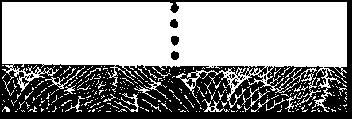 Type D - November 1920 to December 1924 |
Types of Lathework
The first use of paper within a pane to convey something other than textual messages was the 1978 CAPEX souvenir sheet, which featured both the CAPEX 78 logo as well as the logo of the Universal Postal Union.
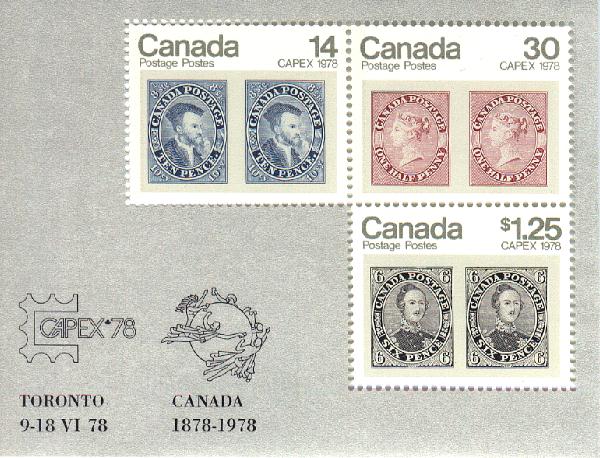 |
Tabs, which are spaces where stamps would normally be printed, are also used to convey information as well as to serve as a convenient space for additional artwork. The souvenir sheet issued to commemorate the 1982 International Philatelic Youth Exhibition is the first example of the use of a tab for artistic purposes. The tab in this souvenir sheet contained stylistic pictures of two postage stamps. Prior to this issue tabs were either blank or contained only text messages such as COLLECT CANADIAN STAMPS or REMEMBER THE POSTAL CODE.
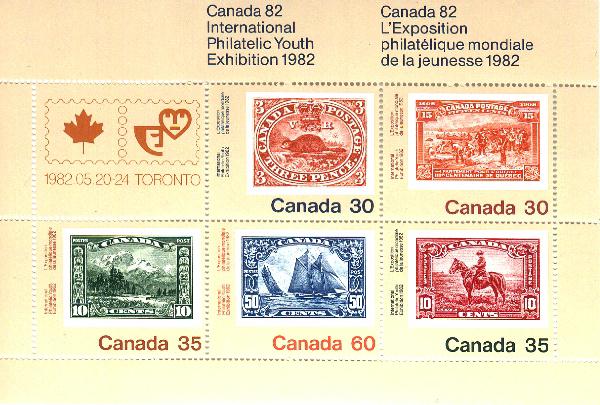 |
The 1983 Canada Day issue was a booklet containing 10 different stamps commemorating historic forts. This is a special issue for two reasons: it was the first time Canada Post issued commemorative stamps in booklet form, and it was the first example of the use of selvedge to provide additional explanatory information about each stamp.
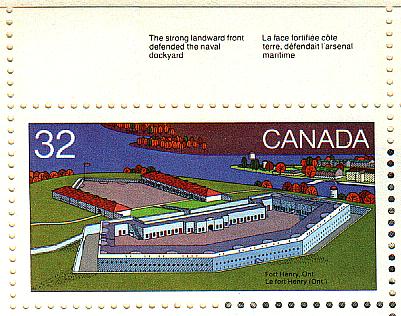 |
The souvenir sheet issued in 1984 to commemorate the National Philatelic Exhibition in Montréal contained four stamps that featured steam locomotives, and the selvedge depicted a line drawing of a locomotive alongside the logo of the exhibition.
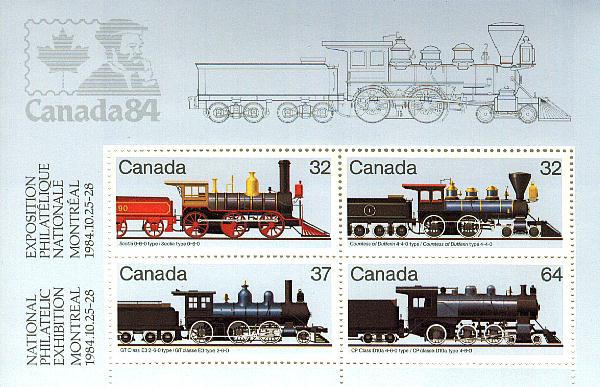 |
The CAPEX 87 souvenir sheet issued in 1986 is the first Canadian example of the entire selvedge being used as a backdrop for a picture. Until this time, individual drawings were made on the selvedge. The overall effect of this sheet is of four stamps, depicting exploration themes, within a larger picture.
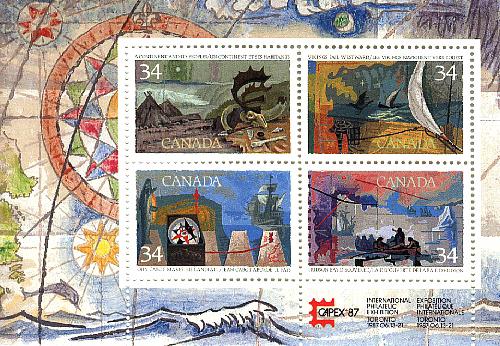 |
The first issue featuring selvedge art in a format other than a souvenir sheet was the 1990 Canada Post booklet containing three panes, each with images commemorating something about Canada Post's history. The sheet illustrated below is from that booklet.
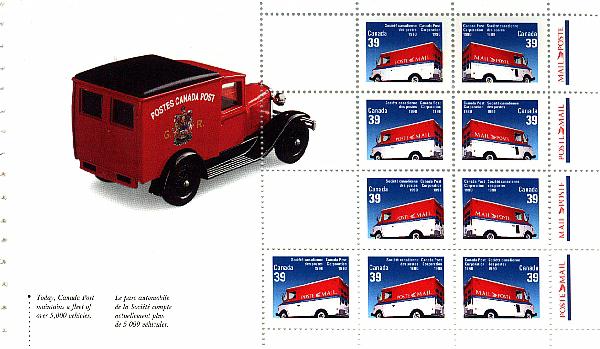 |
1990 was also the year of the first postal corporate sponsorships. PETROCANADA sponsored souvenir panes of the Majestic Forests of Canada series, and McDonald's Restaurants sponsored the Canadian Folklore issue. In the case of McDonald's, the company's famous golden arches logo was featured on the selvedge. Many other companies and organizations have followed suit, with their logos adorning the selvedge of the issues they have sponsored.
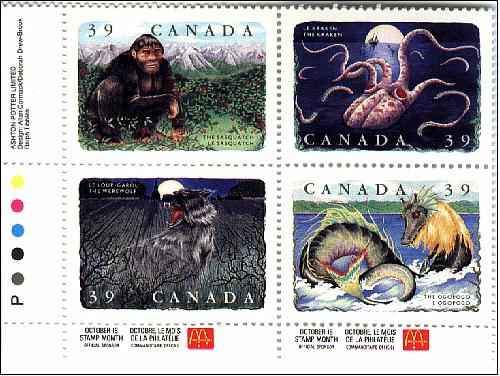 |
The 1993 Canada Day souvenir sheet was the first of a number of such sheets with oversized selvedge on the top to provide room for ever more striking artwork. In this case, the issue commemorated Canada's provincial and territorial parks, and the selvedge bore an additional painting of a forest scene from Algonquin Park.
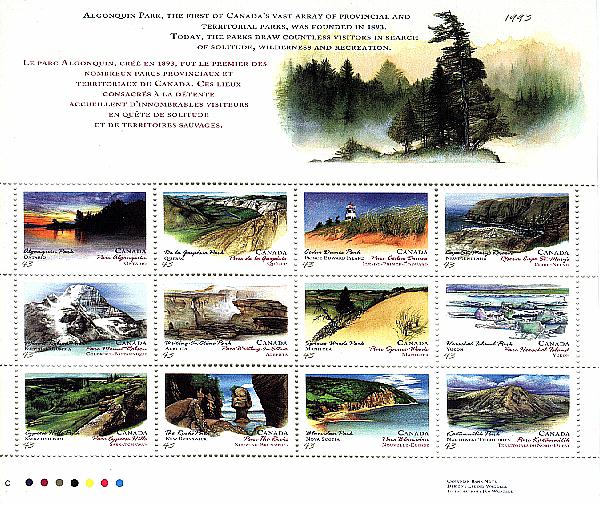 |
1994 saw the first use of tabs that were not the same size as the associated postage stamps within the pane. The issue commemorating the life and times of Canada's first woman Governor General, Jeanne Sauvé, featured four unique offset tabs, each one depicting a particular phase in her life.
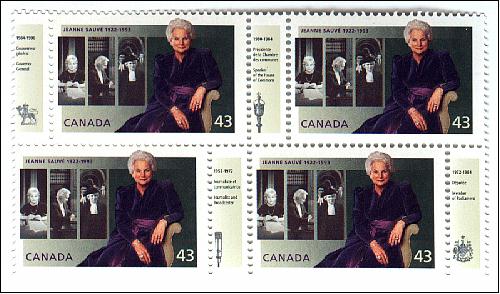 |
Again in 1994, the souvenir sheet issued to commemorate the International Year of the Family took selvedge art to a new level. This pane gives the impression of a complete painting across an entire sheet, with the five stamps punched out of the picture. The effect is that of a single continuous scene flowing from selvedge to stamp, perhaps reflecting the never ending cycles of life in family situations.
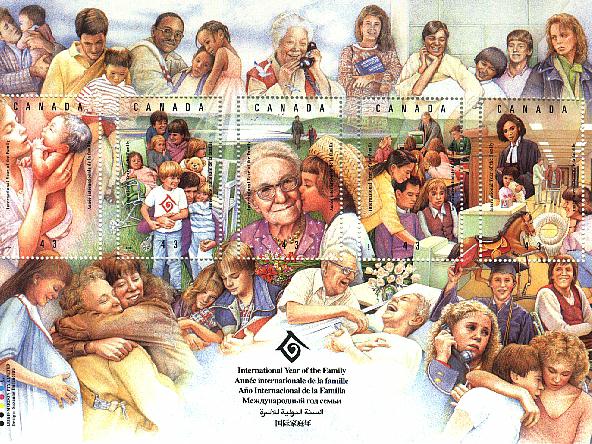 |
Treatment of the subject of selvedge art would not be complete without a reference to the imaginative ways in which the traffic lights are sometimes depicted. While they are normally represented as coloured dots, once in a while they can reflect the theme of the issue, as in the case of the 1996 Literacy issue where the traffic lights are in the shape of jigsaw puzzle pieces to complement the jigsaw puzzle motif reflected in the pane.
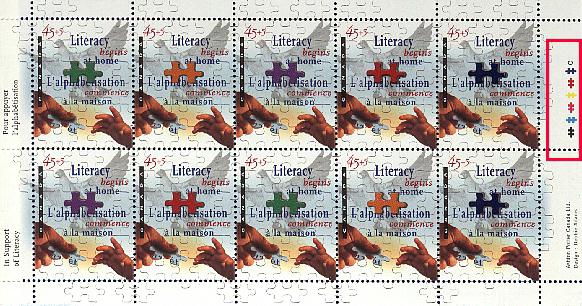 |
The 1997 Year of the Ox Issue displayed an imaginative use not only in the art depicted on the selvedge, but also by its unique shape, that of an oriental fan, which further enhanced its thematic purpose of honouring the Chinese New Year.
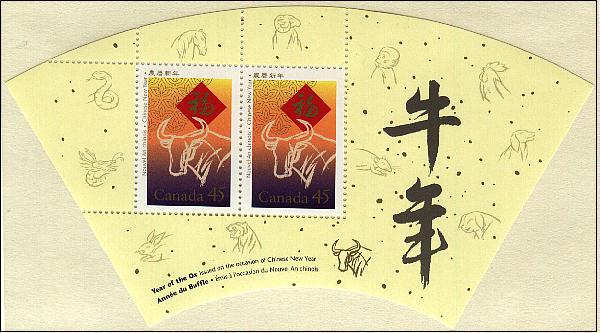 |
The 1997 issue commemorating the 100th Anniversary of the Victorian Order of Nurses provides another example of the use of selvedge to portray thematic information that might have otherwise been featured within the stamp itself. In this case, the portrait of the founder of the Victorian Order of Nurses, Lady Ishbel Aberdeen, is shown on the corner piece of the selvedge.
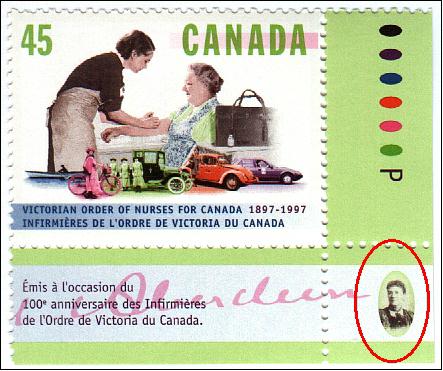 |
Last but not least is this interesting illustration of another use of tabs. In the 1997 issue to commemorate the opening of the fixed link connecting Prince Edward Island to the New Brunswick mainland, a tab, featuring a central portion of Confederation Bridge, is used to link two stamps, each featuring a portion of the bridge.
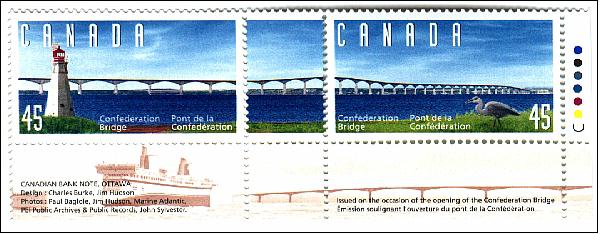 |
In conclusion, the use of selvedge for artistic purposes brings an added dimension that serves either to enhance the message meant to be conveyed by the postage stamps themselves or by actually conveying additional information. We have seen numerous examples of the use of tabs and selvedge to date. No doubt we shall see many more in the years to come.
| The author
would very much appreciate any feedback on this publication. Information pertaining to errors and omissions, helpful suggestions, and offers to provide additional material, etc, are more than welcome. |
|
All rights reserved. No information contained within this publication is to be used for financial gain without the expressed, written permission of the author.
Updated: 10 Oct 97